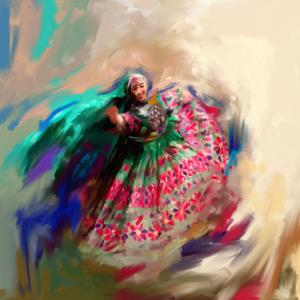Sale on canvas prints! Use code ABCXYZ at checkout for a special discount!

What is Attan?
Attan is a form of dance that originated in Afghanistan. Attan began as a folk dance conducted by Pashtuns in times of war or during weddings or other celebrations (engagements, new year, and informal gatherings). It is now considered the national dance of Afghanistan.
Attan as part of the Pashtun Culture
The performance of Attan dance in the open air has long been customary in the Pashtun culture and is carried by all Pashtuns, of all ethnic groups.Attan is a special type of dance performed by a troupe of 50 to 100 dancers who wave red scarves in the air while musicians beat drums. This dance is common among the Pashtuns and is promoted as the national dance of Afghanistan.
What is the attire for Attan?
Performers often wear traditional regalia when participating in the lively dance. For men, the pakol (a thick wool hat) is usually worn, as well as a waskata (thick wool vest).Usually during the celebratory occasions, men can also be seen wearing suits and ties for a more formal look. The women can be found wearing bright, colorful dresses. These dresses can be accompanied with tiny mirrors on them which are said to symbolize light. The tiny mirrors add great detail and shine under the lights as the women move and dance.
What are the different types and styles of Attan?
The Attan is performed differently in many of the different Pashtun tribes. Some styles of Attan portray themes of war while others portray celebration, especially for events such as marriage, engagements, family gatherings and also as a prelude to the arrival of spring.
All different kinds of Attan are danced with the beats of the drums. However they all differ in style. The beater of the drum known as "Dum", who instantaneously change the rhythm, is circled by the performers.
CATF’s depiction of Attan
Visit our Pashtun gallery today and check out our ‘ Attan Artworks’ depicting the wholesome glory and vibrancy of this lively, traditional dance.